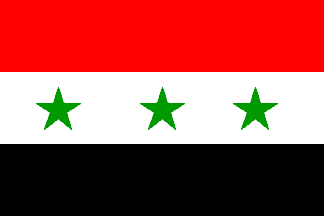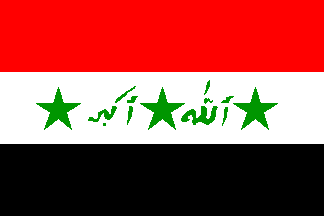 by Mark Sensen
by Mark Sensen
Last modified: 2008-01-26 by eugene ipavec
Keywords: stars: 3 (green) | text: arabic (green) | iraq | triband | allahu akbar | takbir |
Links: FOTW homepage |
search |
disclaimer and copyright |
write us |
mirrors
On this page:
See also:
Egypt and Syria formed in 1958 the United Arab Republic. The new republic adopted a flag made of three horizontal
red-white-black stripes, with two green stars placed on the white stripe. The two stars represented the two
states which constituted the republic. In 1961, Syria left the UAR but Egypt kept using the name of UAR and the flag until 1 January 1972. In 1963, Egypt, Syria and Iraq tried to constitute a new union, to no avail. The
proposed flag for the union should have been the same as the UAR flag, but with three stars symbolizing
the three states constituting the union. The union never existed but Iraq retained the proposed flag as its national
flag. The official explanation of the three stars was they should remind Iraqi attempts to unify the Arab countries.
Ivan Sache, 13 Jul 2003
For more on the symbolism of the Iraqi flag, see the main page on Iraq.

image by Mark Sensen
Adopted 13 January 1991
The takbir (Allahu Akbar (God is great) in Arabic script) in
green was added to the 1963 flag during the Gulf
War, 13 January 1991. The Arabic text may be read from right to left on both sides of the flag,
which are identical.
Juan Manuel Gabino Villascán, 08 Jan 2001
The flag shown above containts text with an unfinished Kaf (Arabic letter
similar to a "K" in English), while during the Olympics held in Barcelona
(1992), Atlanta (1996), and Sydney (2000), as well as at the Iraq embassy in
Mexico and in front of the United Nations building, flags with a complete kaf
were/are shown. In the same way, such flags do not/have not had those marks
(accent mark-like) over the alif, but they did/do over the lam.
Juan Manuel Gabino Villascán, 08 Jan 2001
The first picture above was created by somebody who
was not familiar with the Arabic alphabet (as is only too obvious to those who are
familiar with the Arabic alphabet).
anonymous, 06 Oct 2002
I would like to comment on Juan Manuel Gabino Villascán's description of the variants of the inscription
Allahu Akbar (the Takbir) on the Iraqi flag. In both variant the letter kaf is written completely.
The difference is the style of writing. I think the main variant [above] uses the Ruq`a which is common in
handwriting, while the other variant [below] uses either Naskh or Thulthi which is common in printed texts.
The word Allah is usually written accented (with vowels) even in non-accented texts, while other accents
are optional, and are added according to writer's decision, so it is not surprising to see variants in accenting.
The hamza over the alif of Allah in the main variant seems to be a spelling mistake,
according to formal rules, but it is a common mistake which appears in many texts.
Dror Kamir, undated
This discussion triggered what I think is a memory but may be a fantasy that the
presentation of the words on the official version of the Iraqi flag is an exact copy of
Saddam Hussein's handwriting. A photograph of Saddam
in front of an Iraqi flag on which the lettering can be clearly seen shows hamzas
above the initial alifs of both words. There are a shadda (the thing that
looks like a little "w") and a dagger alif above the second lam in Allah.
The strokes of the kaf in akbar appear to be connected, but not in a
smooth join. [Comment by Nathan Lamm: The flag folds there.] Otherwise no diacritics
or vowel markings.
Joseph McMillan, 10 Jul 2002
The claim that the takbir added in 1991 to the 1963 flag is a facsimile of Saddam's own handwriting
has been repeated several times, and now it seems that it has become kind of a truth gained by repetition of the claim.
Is there really any evidence that the inscription is Saddam's handwriting? Is this an other flag myth/legend/propaganda?
Željko Heimer, 29 Jun 2004
Whether it is a fact or just a legend, it is a common belief of the vast majority of Iraqis, so it has
a profound psychological impact, not lost to the new government of the prime minister Iyad Allawi.
Chrystian Kretowicz, 29 Jun 2004
I just heard a story on National Public Radio (USA) about the raising of the
Iraqi flag at the newly reoccupied embassy in Washington DC. One of the interviewed people celebrating
specifically cited the change to Kufic script to move away from Saddam's handwriting.
Richard Knipel, 30 Jun 2004

image by Juan Manuel Gabin Villascán
It seems that the second version is too perfect--the letters, as I've always
seen them, are not straight up and thin. The first version is more like it, even if
it is a bit rough. None of the flags have vowels. The version offered by
"Anonymous" [not shown] puts hamzas, a complete consonant even if it looks like
a vowel, on the alifs, while the first version shown above either has that
or the little-used madda. If the former, they cannot be removed; if the
latter, the presence of other diacritics (although no vowels) would indicate that
they belong. The second version above fails because it's too type-perfect and lacking
either of these.
Nathan Lamm, 10 Jul 2002
Several months ago we had a discussion about the exact shape of the inscription in the Iraqi flag.
I get the impression these days that there are different variants in use. I saw two variants in recent TV
news: a flag behind the Iraqi information minister, with very thin inscription, and a flag somewhere in the Gaza Strip
with a more usual variant of the inscription.
Marcus E.V. Schmöger, 23 March 2003
![[Iraq, 2004-]](../images/i/iq2004.gif)
image by Pascal Gross and Graham Bartram
According to an Associated Press report, "U.S. administrators have tried quietly in the past to change the flag by dropping the words
Allahu akbar, but Iraqis have refused to abide by the change. One council member said the Iraqi leadership should wait for an elected
government before altering such a major national symbol. 'In my opinion, it should be not be passed until we have a parliament,' Mahmoud Othman
said. 'I think there are issues more important to concentrate on now than the changing of the flag.'"
Mark Sensen, 26 Apr 2004
As I noted before, the 1991 flag (and the arms) included the Allahu Akbar salutation
in Saddam Hussein's
own handwriting. Certainly, the new Iraqi government doesn't want to associate itself with
the former dictator's calligraphy, but taking under consideration the overwhelming rejection of the recently proposed
"blue" flag, got to modify the flag used universally by their people.
Nothing better than using decorative Kufic script, which originated in Iraq, in the town of Kufa (one of the most important cultural centers of an early Islamic period) and is used extensively for the calligraphy of Qur'ans.
It might look like a "block style", but, in reality, it is a venerable Kufic script, well known and admired by
the Iraqi people.
Chrystian Kretowicz, 29 Jun 2004
On June 30 this design was raised over the Iraqi embassy in Washington when it reopened, and the
adoption of this new design seems to be general for high-profile government use at least.
Richard Knipel, 27 Aug 2004
![[Iraq]](../images/i/iq.gif)